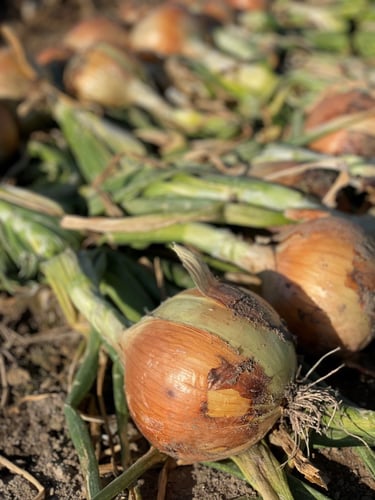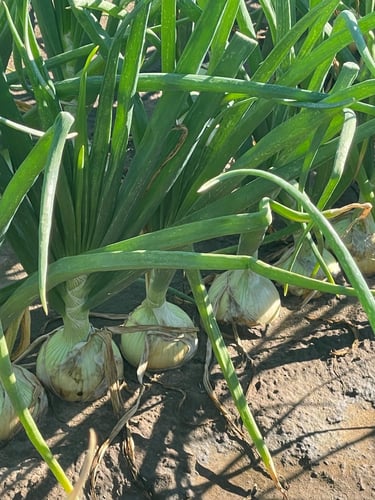By: Victoria Marsh, Western Technical Sales Agronomist
How can something smaller than a grain of rice cause so much damage? You might be wondering what I’m referring to, but here is a hint: it’s a pest that is ubiquitous in many crops but causes consistent damage to onions. It’s small, yellow-green, can reproduce by itself, carries and transmits pathogens, reduces crop size and quality, and is winged. Still not sure, it’s thrips!
Anyone who has grown onions knows what thrips look like. Because they are so small, prolific, and mobile, control is extremely hard and extremely important. Thrips are found throughout the globe impacting onion growers across the world causing the need for control to protect yields. Before we jump into control let’s talk about why we need to control them.
Thrips are such prolific pests because of several physiological traits they possess. First, they have a very low generation time—this is the timeframe from birth to reproduction and it’s only 7-14 days (hot weather increases thrips time to reproduction). This means that from hatching to laying is about a week. When you look over this in a season, in hot and dry growing areas there can be as many as 40 generations of thrips created—where more normal numbers range between 10-20—still that’s a lot of thrips. Each generation is growing in numbers and potential resistance to insecticides. And when it comes time for thrips to lay eggs, they either lay them on the surface of the leaf or at times can create galls and embed their eggs in the tissue of the plant. Thrips also don’t mind being on their own because they can reproduce with a partner or by themselves, reducing the barriers to increasing populations in the field.

What do thrips do to onions? They have rasping mouth parts and when they feed, they essentially “punch” through the cell walls of the leaf and extract sap from the plant. After this, they then siphon plant contents including chlorophyll. This results in a reduction of photosynthesis which in turn will reduce bulb weight and cause plant stunting. These feedings also result in a broken cell-wall structure which allows for loss of water and a predisposition to fungal and bacterial pathogens as well as the Iris Yellow Spot Virus. Studies have seen as much as a 50% reduction in yield due to severe thrip infections in onions, so control is a must to protect your crop.
Insecticides are needed to control these pests and are normally sprayed anywhere from twice a month to weekly. Sadly, these insects have gained resistance to several classes of insecticides due to their high reproduction rate and generation time. But control is still possible and should be prioritized.
There are new insecticides and control methods that are making thrip control easier. One of these is Averland® FC from Vive Crop Protection. This product is a translaminar insecticide/miticide/nematicide, that is perfect for in-season thrip control. Built with Vive’s patented Allosperse® Delivery Technology, Averland FC can be seamlessly mixed with liquid fertilizers, foliar feeds, micronutrients, and other crop inputs without causing any tank mix issues for an easier and more efficient in-season application. This flexibility allows a grower to easily apply liquid fertilizer, knock down weeds, and spray for thrips all at the same time… with no issues!
In any successful thrip control program, a need for multiple modes of action is essential. But adding Averland FC to this rotation will allow for better thrips control while also increasing the efficiency of the application.
Kick those thrips out of your field this season! Happy farming!

Important: AVERLAND FC IS A RESTRICTED USE PESTICIDE. Always read and follow label instructions before buying or using Vive Crop Protection, Inc. products. Allosperse®, Averland®, and the Vive Crop Protection® logo are trademarks of Vive Crop Protection. ©2023 Vive Crop Protection Inc.
